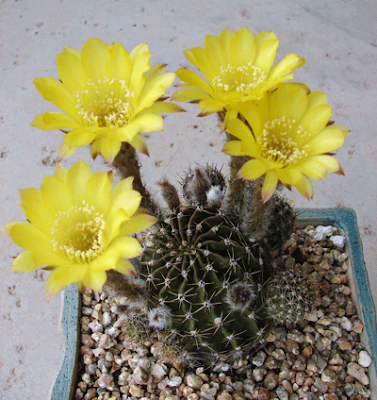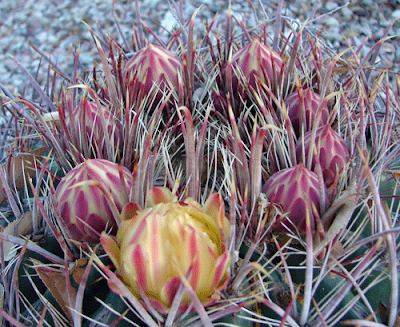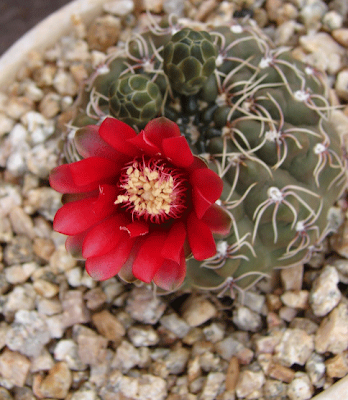Saturday, May 30, 2009
Chameleon
Tuesday, May 26, 2009
Cactus Flowers
A very small Echinopsis with a huge flower. I took this late one night last week to catch the flower at its peak. The cactus produces one flower each year, which probably wears it out! As the cactus gets older, it should produce more flowers each season.


Monday, May 25, 2009
Unlearned Lesson ~ Memorial Day
Tuesday, May 19, 2009
Mixed Bag
My Red Bird of Paradise bushes have finally started to bloom. I've been seeing them all over town, lush and full of flowers, but my shrubs don't look so hot this year. The foliage is sparse, and although all the bushes have some flowers, they just don't look right. It's my own fault because I did not prune them back last fall. You can prune these shrubs down to the base each year and they will come back looking great.
I just love this tiny clay pot. It's 2-3/4 inches high and 4 inches in diameter. I bought it last year at a cactus show and sale, and it was already planted with a tiny Lawyer's Tongue offset. The offset has grown to the point I need to repot, but I'm wondering how I'm going to get it out of this pot without damaging the pot or the offset. The pot maker sold out of these popular little pots by mid morning.
I showed this same cactus in last week's post, but because it has been so prolific, I took another photo again today. These flowers are the latest of 12 so far. It's supposed to be a repeat bloomer with intermittent flowers over the summer. If so, it's going to be on my list of favorites!
The second year for blooms on this Giant Chin cactus. I had it for years before it ever flowered, and the blooms have always been sparse. This year it has about 12 buds--a record for this specimen. The flowers are not as attractive as many other Gymnocalycium species. Most collectors have it for its form rather than the flower.
One of the hosts at a garden tour stop gave me a cutting of Desert Petunia about four years ago. I can always count on it for a few spots of color. This is another plant that can be cut back to the base in the late fall, and it will come back almost immediately, looking fresh and full. It provides flowers off and on all year except in December and January.
We've had thirteen consecutive days of temperatures over 100 degrees since May 1st, which is a record. Today was 108 degrees. This does not mean it will be hotter than normal the rest of the summer, but normal is not pleasant!
Sunday, May 17, 2009
Sunday Stuff

So far, my Santa Rita Prickly Pear has retained its winter purple. I love the way the purple pad made for a colorful backdrop for the flower bud.
A young Anna's Hummingbird found a resting place on a pot ring right outside my breakfast area window today. I took this photo through the window.
The fruit on my new dwarf Meyer Lemon tree is still hanging on. I have 28 lemons growing right now. I'm hoping at least a few will last until ripe. It's odd that blossoms are still appearing even in May. Not normal in my opinion.
Tuesday, May 12, 2009
Color Range
The Gymnocalycium baldianum species has flowers that range from white, pink, orange and bright red. I've looked for one of the white flowered ones without any luck. Each year, my G. baldianum has flowers that range from pink to a salmon pink color. This year, it looks like they are more in the pink range.
My one red G. baldianum is still small, but this species can bloom at one year old. I've found over the years that Gymnocalycium baldianum will bloom over and over from late April until September. If anyone ever wants a cactus that produces prolific flowers, this is it.
Most of my Parodia species have flowered or in the process right now. They will soon finish up for the season, but may produce another round of smaller flowers in a few weeks. I never know.
Saturday, May 9, 2009
Tiny But Nice
The cristate form of this cactus has blooms that run parallel. With time, this small cactus can grow to about 18 inches wide with large tangled mounds. Collectors like it because is freely flowers, unlike some other cristate forms of cacti.
The common name of this cactus is Cabeza de Viejo. It is too tender for for our intense sunlight, so I keep it on the patio year round. It takes very little water, and the expected bloom period is in January and February, but this one consistently blooms in April and May.
 Mammillaria magnimamma
Mammillaria magnimamma The flower color on this species can range from pale pink to red. I've seldom seen specimens with the same coloration as mine.
Tuesday, May 5, 2009
Cat Casualty and Cactus
Sunday, May 3, 2009
Ready For Occupancy

I've been interested in Mason Bees (Osmia lignaria) since reading an article about them in a University of Arizona publication last fall. Until I read the article, I didn't know a thing about them, or that they occur naturally in Arizona as well as throughout the United States. These bees are smaller than honey bees and almost black in color. They are docile and friendly, and do not normally bother humans if they are not bothered. They are not destructive like carpenter bees because they do not excavate nest holes for themselves. The way to attract them is to provide them a bee house all ready for nesting. The nests are placed facing east or south. In Arizona, the bee house can go up from February to July to attract the bees.
Supplying a ready-made nest helps the female Mason bee spend less time and effort on nest preparation and more time on gathering nectar and pollen and laying eggs. First, she places a mud plug at the bottom of the tube, then brings 15 to 20 loads of nectar and pollen from spring flowers until she has enough to begin laying an egg in the tube. Then, she will plaster the opening of the tube with a mud plug, and move on to prepare and complete the next tube and so on. She only lives for about a month, and will produce one or two eggs a day. The eggs become larva, which feed on the pollen pellet. After it consumes the pellet, it spins a cocoon and pupates within the tube cell. Around September, the larva transforms into an adult bee that stays in the plugged tube until the following spring. And the cycle begins again.
So far, no Mason bees have nested in my bee house. I wonder if I got it up too late in the season, or if there are no Mason bees around here yet. I guess I'll just wait to see if any show up between now and July. I hope so, as I was looking forward to watching them at work.
Honey bees aren't interested in the nests, but some leaf cutter bees and wasps will build nests in the bee house, so I'll have to watch for that. You can tell if something other than a Mason bee has filled a tube. The Mason bee plugs have a rough mud surface, the wasp mud plugs are smooth, and the leaf cutters seal their tubes with chewed leaves so they are green in color.





















